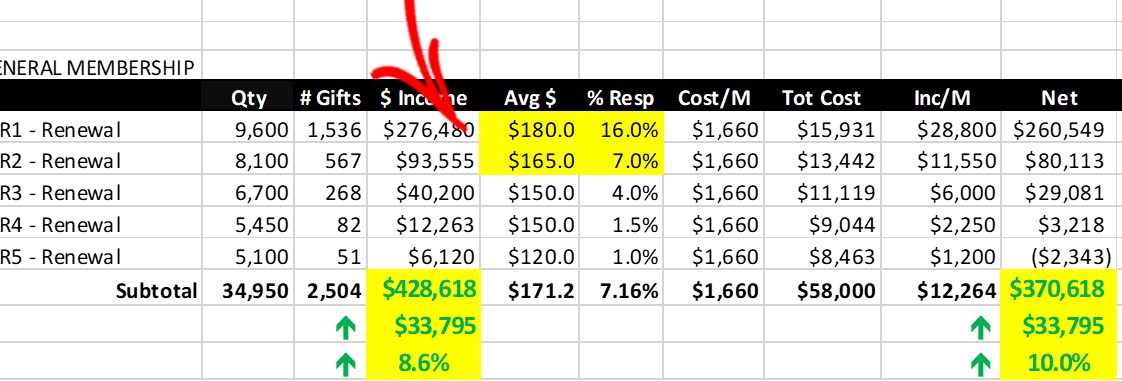
Good direct marketing is counterintuitive in so many ways. When we evaluate our programs looking for ways to improve them, we naturally zero in on the problem areas. What problems do I need to fix to make my program better?
But instead of focusing your energies on identifying and fixing perennial problem areas, you’d actually be better served seeking your areas of strength, and building on them. Because when you want to really move the dial and raise more money, your potential for doing so lies within the best performing segments of your file, not the worst ones.
It’s a matter of simple math.
Here’s an example of a perfectly solid direct mail renewal series for a social service nonprofit organization (click the table to view larger):
And here are the key performance indicators (click table to view larger):
You can see that response rate is highest in the first two renewal notices (15% in notice #1 and 6.5% in notice #2), and then steadily declines, as it should, with each subsequent notice.
Now, let’s say you do something strategic to boost response to notice #1 by one percentage point. You also boost response to notice #2 by half a percentage point. (For instance, you laser personalize the recipient’s membership details on the reply device, or you add an incentive to respond, like a deadline-based challenge, or you try one of dozens of other direct marketing strategies to improve performance.)
And let’s say you also do something to increase the average gift to both notices by $5. (Perhaps you modify your ask calculation formula, or share compelling equivalencies that drive a higher gift amount.)
Here’s what happens when you make those small improvements in those first two notices (click to view larger) :
You raise almost $34,000 more! That’s an 8.6% increase in revenue. And because it’s a pure net increase, your net revenue increases by 10%.
Your strategy to focus on the best performing part of your file, at the strongest point in the series clearly pays off.
But what if you had focused on the problem parts of the file and series instead?
What if, in your endeavor to improve your results, you had looked at your original renewal series results (that first table above) and said: “Wow those first two notices are already doing great! No problem there. But look at that 1.5% response to notice #4. And that 1% response to notice #5. If I want to improve my results, I should really be working on those low performing notices #4 and #5.”
And so you apply your smart direct marketing strategies to notices #4 and #5 instead, raising the response rates and average gift by the same amount in our first scenario (i.e. +1 percentage point in notice #4, + 1/2 percentage point in notice #5 and +$5 average gift to both notices).
What happens?
You do improve revenue, but by far less. Your total revenue increases by only $12,298, or 3.1% (compared to your increase of $34,000 and 8.4% when you apply your strategies to notices #1 and #2).
So the next time you find yourself weighing your options for strategy direction—should you fix a problem or build on a strength?—start by doing what revenue-minded direct marketers do: the math.










